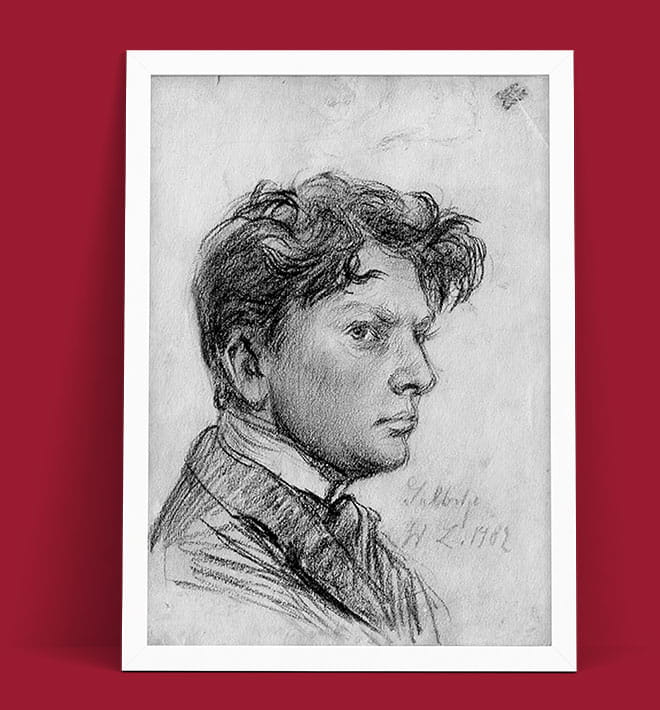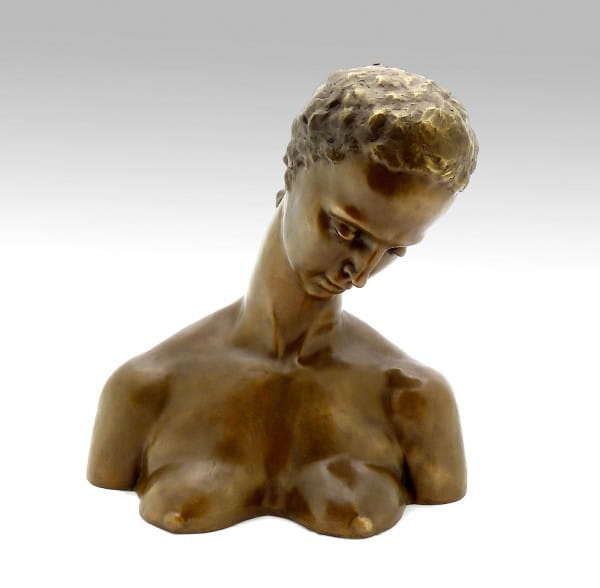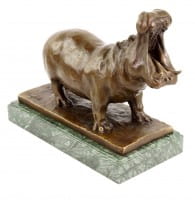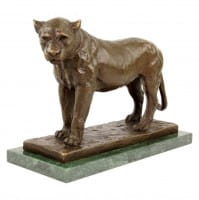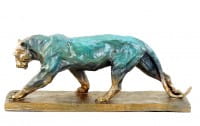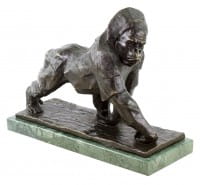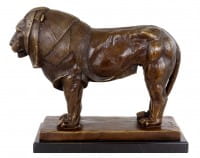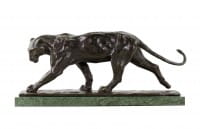Prices incl. VAT, free shipping worldwide
Ready to ship today,
Delivery time appr. 3-6 workdays










Product description
"Wilhelm Lehmbruck - Bronze Bust - Inclined Head of a Woman"
| Weight | 8,6 kg |
Silent Grace in Bronze: Wilhelm Lehmbruck’s “Inclined Head of a Woman” (1911) - Signed
The bronze bust titled Inclined Head of a Woman, created in 1911 and signed by Wilhelm Lehmbruck, is one of the most emotionally resonant pieces in early modern sculpture. In this work, Wilhelm Lehmbruck—born on January 4, 1881 in Meiderich (today a district of Duisburg) and deceased on March 25, 1919 in Berlin—transcends the boundaries of traditional academic sculpture. With its bowed head, elongated neck, and contemplative gaze, the bust captures an introspective stillness that resonates deeply with the viewer. The sculpture exemplifies Wilhelm Lehmbruck’s distinctive style: a melancholic lyricism shaped by existential thought and the vulnerability of the human form. This powerful bronze is more than a portrait—it is a poetic monument to the inner world.
A Masterpiece Born in the Crucible of European Modernism
Inclined Head of a Woman was sculpted in 1911 during a critical moment in Wilhelm Lehmbruck’s life and career. At that time, he was working in Paris and engaging with the ideas of contemporary artists such as Auguste Rodin and Aristide Maillol. Paris in the early 20th century was a vibrant center of sculptural innovation, and Wilhelm Lehmbruck immersed himself in the tensions between classical form and modern expression. This bust, cast in bronze, reflects that duality: it retains classical proportions while subtly breaking away from realism. The surface is polished yet organic, smooth yet breathing with life. The head's downward inclination and the closed posture of the bust emphasize modesty, introspection, and inner concentration—hallmarks of Wilhelm Lehmbruck’s aesthetic philosophy.
A Face that Speaks Without Words
When studying the sculpture, one is immediately drawn to the tenderness of the facial features. The closed eyelids and delicately shaped mouth suggest a moment of withdrawal from the world. The tilted head rests slightly on the elongated neck—a gesture that suggests both physical and emotional fragility. The bust does not assert itself with theatricality. Instead, it invites stillness. The exposed shoulders and absent arms heighten the vulnerability of the figure. Every curve, from the rounded forehead to the sloping shoulders, is intentionally crafted to express internal states of being. This is not a portrait of a specific woman but a symbolic representation of the feminine spirit as envisioned by Wilhelm Lehmbruck.
Sculpting the Inner Landscape
Wilhelm Lehmbruck believed that sculpture must not simply depict outward beauty but rather serve as a mirror to the soul. In his works, emotional depth always outweighs ornamental detail. This bronze bust is a prime example of that approach. Here, the outer simplicity is a vessel for an inner complexity. Wilhelm Lehmbruck once said, “My figures are all ‘inner forms,’ forms of feeling.” That sentiment is sculpted into every millimeter of Inclined Head of a Woman. The figure is not defined by dramatic gestures but by the subtle modulation of line and form. The slight bend of the head expresses more than any extended limb ever could. This is a bust born not of spectacle but of sincerity.
A Female Archetype in the Language of Bronze
In this sculpture, Wilhelm Lehmbruck creates a feminine archetype—one defined by calm strength and silent resilience. The woman’s pose is not one of defeat but of contemplation. She seems caught in a moment of thought, inwardly focused. The bust carries echoes of classical Roman and Greek sculpture in its poise, but it breaks with antiquity through its psychological depth. This unique synthesis is what defines Wilhelm Lehmbruck’s artistic contribution. The bronze medium amplifies these qualities: it lends the work permanence, solidity, and gravitas. The soft sheen of the patina animates the surface, drawing out shadows and light like the quiet fluctuations of thought itself.
Wilhelm Lehmbruck’s Life Shaped by Emotion and Intellect
Understanding this bust also requires a deeper knowledge of Wilhelm Lehmbruck’s biography. Born in the industrial Ruhr region, he grew up amidst factories and coal mines, yet he gravitated toward the arts early in life. He studied at the Kunstakademie Düsseldorf and later moved to Paris, where his exposure to modernist movements transformed his outlook. Profoundly affected by World War I, Wilhelm Lehmbruck’s later works grew darker, more inward, and more spiritual. He struggled with depression throughout his life and ultimately took his own life in 1919. His works, including Inclined Head of a Woman, thus carry traces of both immense sensitivity and existential questioning. They are windows into a soul haunted by the world yet longing for beauty.
An Enduring Presence in the Museum World
Today, original versions and authorized casts of Inclined Head of a Woman can be admired in several renowned museums. Most notably, the Lehmbruck Museum in Duisburg houses a significant collection of Wilhelm Lehmbruck’s works, including this bronze bust. The museum is dedicated to preserving his legacy and contextualizing his contributions within the evolution of modern sculpture. The bust is also referenced in major international collections that explore early 20th-century European modernism. Through these institutions, Wilhelm Lehmbruck’s vision continues to live on, and visitors from around the world can encounter his art in quiet, reverent contemplation.
A Timeless Sculpture Rooted in the Human Spirit
Inclined Head of a Woman remains one of Wilhelm Lehmbruck’s most poignant sculptures. It is not bound by time, place, or cultural specificity. Instead, it speaks to something universal: the quiet dignity of introspection. The sculpture is an invitation to pause, to turn inward, to reconnect with our own emotional landscapes. As a viewer, one does not merely observe the bust—one feels alongside it. It is a vessel for silence, grace, and human presence. Through its restrained elegance and profound emotional resonance, this bronze figure becomes a timeless embodiment of Wilhelm Lehmbruck’s artistic genius.
Height: 43 cm
Width: 36 cm
Depth: 23 cm
Weight: 8,6 kg
100% Bronze
Our advantages
free shipping
Worldwide free shipping
14 days money back
You can cancel your order
within 14 days
secure payment services
Paypal, Master Card, Visa, American Express and more

